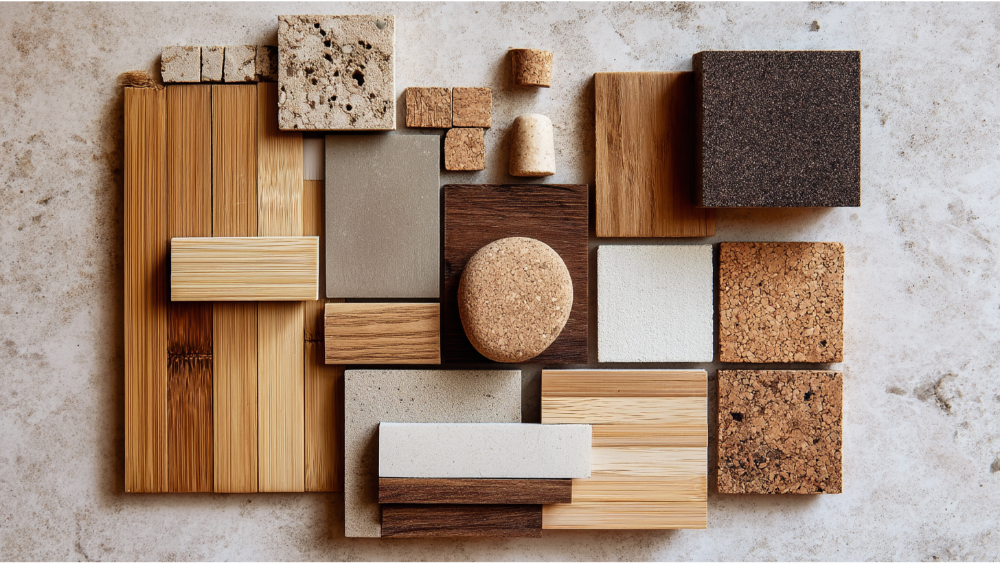Partnered with #1 ADU Builders
Contact Golden State
Drop us a line! We look forward to discussing your next project with you!
Cut the chase! Schedule a face-to-face virtual meeting with us today to dive into your project's next steps.
For our returning clients, experience our streamlined, contact-free project proposal process. Simply fill out our short project questionnaire, and we'll deliver your project proposal within 72 hours.
Contact Us:
Follow Us:

- Golden State Design & Engineering
- Comment 0
Sustainable Building Materials: A Smarter Path to Greener Construction in California
Why Sustainable Building Materials Matter in the Construction Industry
The construction industry plays a significant role in shaping communities across California, but it also has a massive environmental impact. Buildings account for nearly 39% of global carbon emissions, including both operational and embodied carbon. As climate concerns rise and regulatory standards tighten, builders, designers, and engineers are turning to sustainable building materials to reduce carbon emissions, minimize waste, and protect natural resources.
Sustainable building materials are at the core of environmentally responsible construction practices. They help reduce a structure’s overall carbon footprint, lower energy consumption, and support healthier indoor environments. For developers, homeowners, and construction professionals looking to balance cost, performance, and ecological impact, choosing the right construction material is more important than ever.
At Golden State Design & Engineering (GSDE), we integrate sustainable construction methods into every phase of a project, from design and engineering to permitting. By prioritizing material efficiency, innovative construction techniques, and the use of renewable resources, we help clients meet today’s sustainability expectations while delivering energy efficient, high-performing, and durable structures. Our approach ensures that sustainable practices are implemented seamlessly from the construction site to project completion, leveraging renewable energy sources whenever possible to further reduce environmental impact.
Top 5 Sustainable Construction Materials Used in 2025

Cross Laminated Timber and Mass Timber Systems
Cross laminated timber (CLT) is a form of engineered wood made by gluing layers of wood in alternating directions, forming a strong and stable structural panel. CLT is one of the most promising sustainable construction materials today. It stores carbon dioxide during tree growth, reduces reliance on traditional construction materials like concrete and steel, and offers an appealing natural look.
Mass timber systems, including CLT, offer a sustainable alternative for low to mid-rise residential buildings, ADUs, and commercial spaces. These materials are lighter than concrete, reducing foundation loads and simplifying the construction process. In earthquake-prone regions of California, mass timber offers strength, resilience, and sustainability in one solution.
1 | Recycled Steel and Ferrock
Steel is one of the most commonly used construction materials worldwide. Traditional steel production contributes significantly to greenhouse gas emissions. However, recycled steel presents a low-impact solution. It maintains the strength and versatility of virgin steel while reducing the carbon footprint and lowering resource extraction.
Ferrock, made from recycled steel dust and other industrial byproducts, is a cutting-edge eco friendly construction material that absorbs carbon dioxide during curing. Ferrock not only outperforms concrete in compressive strength but also contributes to sustainable construction practices by utilizing recycled materials and supporting carbon capture.
2 | Low Carbon Concrete and Precast Concrete Alternatives
Concrete production process is responsible for a large share of global carbon emissions due to the use of portland cement. Innovations like low carbon concrete and low carbon cement are reshaping the construction sector. By incorporating recycled concrete, fly ash, slag, and other supplementary cementitious materials, manufacturers are significantly reducing the environmental footprint of concrete.
Precast concrete is another sustainable method that allows for precision manufacturing, less waste, and faster construction times. These systems are ideal for retaining walls, foundations, and public infrastructure. When combined with energy efficient design, precast systems help achieve measurable energy savings over time.
3 | Hempcrete, Straw Bale, and Other Bio Based Materials
Bio based materials such as hempcrete and straw bale are growing in popularity for their thermal performance and low embodied carbon. Hempcrete, made from the woody core of the hemp plant and lime, is fire-resistant, mold-resistant, and fully biodegradable. Straw bale construction offers high insulation values, excellent indoor air quality, and can be used in load-bearing or infill wall applications.
These materials are perfect for net-zero homes and rural projects in areas like El Dorado Hills and Santa Rosa. Other bio based materials, such as mycelium insulation and algae bricks, are also gaining traction in sustainable construction projects focused on innovation and long-term performance.
4 | Recycled Plastics, Rubber, and Reclaimed Wood
Recycled plastic and recycled rubber are becoming integral to green building efforts. These materials are used in insulation, composite lumber, flooring, and drainage systems. By diverting construction waste and plastic pollution from landfills, these products support circular construction practices and reduce dependency on virgin materials.
Reclaimed wood remains one of the most in-demand eco friendly construction materials. Salvaged from demolition waste or repurposing materials from old structures, reclaimed wood provides a unique aesthetic, reduces the need for deforestation, and offers a second life to high-quality lumber. Its durability and character make it a favorite in sustainable building projects across California.
5 | Natural Stone, Rammed Earth, and Straw Bale
Natural materials like local stone and rammed earth provide impressive thermal mass and natural insulation properties. In areas with warm climates and dry soil conditions, rammed earth walls can drastically reduce energy consumption by stabilizing interior temperatures. Natural stone, when locally sourced, supports environmentally friendly construction by reducing transport emissions and supporting regional economies.
These traditional building materials are regaining popularity in sustainable construction due to their long lifespan, low embodied carbon, and compatibility with passive design strategies.
Sustainable Construction Methods and Decision-Making

Project Type and Scale
The type of construction project often determines which sustainable materials are most effective. In residential buildings like custom homes or accessory dwelling units (ADUs), lighter materials such as engineered wood, recycled insulation, and natural stone can be used efficiently. For larger construction projects like townhomes or multi-family residences, recycled steel and precast concrete systems are more suitable for structural demands.
Climate and Building Codes in California
California’s climate diversity, seismic activity, and fire-prone zones demand regionally appropriate sustainable construction practices. Materials must comply with Title 24 energy standards and CALGreen regulations. In wildfire-prone areas, construction firms must prioritize fire-rated sustainable materials like metal roofing, CLT with fire treatment, or fiber cement siding.
Water efficiency is also key, particularly in drought-affected counties. Low-impact development practices, such as permeable paving and stormwater harvesting, are essential complements to sustainable construction materials.
Balancing Budget and Energy Efficiency
Sustainable building materials can carry higher upfront costs, but they typically offer strong returns in the form of energy savings, reduced maintenance, and long-term durability. When paired with energy efficient systems such as solar panels, high-efficiency HVAC units, and passive ventilation strategies, sustainable buildings offer superior value over time.
A comprehensive cost-benefit analysis from GSDE helps clients choose materials that deliver both financial and environmental ROI, especially when leveraging available green incentives and tax credits.
How GSDE Integrates Sustainable Materials into Every Phase of Design

At GSDE, sustainability is embedded in every step of our design, engineering, and permitting process. We don’t just specify sustainable construction materials, we optimize their use for structural performance, energy efficiency, and permitting success.
We use advanced BIM modeling and lifecycle analysis to evaluate materials, reduce embodied carbon, and design energy efficient systems tailored to each project. Our permitting experts work across California jurisdictions to expedite approvals for innovative materials and systems, keeping projects on track and code compliant.
Smarter Construction Through Smarter Engineering
Our civil and structural engineers collaborate closely to design site-specific solutions that maximize the potential of each material. Whether we’re using low carbon concrete for foundations or designing mass timber frames for hillside homes, we engineer for resilience, efficiency, and sustainability.
On the civil side, we implement environmentally responsible construction practices such as erosion control, green infrastructure, and site grading that supports rainwater infiltration and native landscaping.
Real California Projects Built with Sustainable Materials
In 2024, we helped design a custom home in Santa Rosa using fire-resistant cross laminated timber, solar-reflective metal roofing, and reclaimed wood siding. The project exceeded California’s Title 24 baseline by 30%, and the client saw a dramatic reduction in energy consumption within the first six months.
In Sacramento, a recent ADU build incorporated straw bale insulation, low carbon cement for the foundation, and passive design strategies. The structure achieved excellent indoor air quality and energy efficiency while using a significant percentage of recycled and renewable materials.
These projects represent GSDE’s ongoing commitment to sustainable building and responsible construction practices.
Future Innovations in Sustainable Building Materials

The future of sustainable construction is rooted in innovation. Technologies like 3D printing are beginning to revolutionize how sustainable homes and commercial buildings are designed and built. With the ability to create structures from recycled concrete, earth-based inks, or biodegradable composites, 3D printing drastically reduces construction waste and labor demands.
Other innovations include carbon-negative bricks, transparent wood, and AI-powered material analysis that selects construction material blends based on site conditions, cost, and embodied carbon. As the construction industry evolves, sustainable methods and materials will become not just viable, but standard.
At GSDE, we are actively researching and integrating these forward-thinking techniques into future-ready design solutions.
Frequently Asked Sustainable Building Materials Questions
Are sustainable materials more expensive?
While the initial cost of sustainable materials can be higher, they often lead to long-term savings through reduced energy bills, lower maintenance costs, and increased durability.
What is the most sustainable building material?
There’s no single answer, it depends on the project. Cross laminated timber, recycled steel, and hempcrete are among the top-performing sustainable options in 2025.
Can sustainable construction materials be used in small projects like ADUs?
Yes, many eco friendly construction materials are ideal for ADUs and small-scale construction. Materials like recycled plastic insulation, reclaimed wood, and bio based materials are cost-effective and code-compliant.
Do sustainable materials meet California’s building codes?
Yes. Most sustainable materials are approved under California’s evolving Title 24 and CALGreen standards. Our permitting team ensures full compliance.
How can I reduce my project’s carbon footprint?
Start with sustainable design, choose low-impact materials like mass timber or recycled concrete, and integrate energy efficient systems. GSDE can help guide your decisions every step of the way.
Build Smarter with GSDE
Sustainable building is no longer a niche, it’s the new standard. With the right planning, materials, and engineering team, your next project can reduce carbon emissions, conserve natural resources, and support a greener future.
Whether you’re designing a custom home, developing a townhome community, or building an ADU, GSDE is here to help you make informed, environmentally responsible choices.
#NAICS’s:
- 541310 Architectural Services &
- 541330 Engineering Services
DUNS NO:
- 119132267
#SIC’s
- 8712 Architectural Services &
- 8711 Engineering Services
Cage #
- 9R4L5
#UNSPSC’s:
- 81101500, 81101502, 81101505, 81101508, 81101526, 81101533, 81101522

